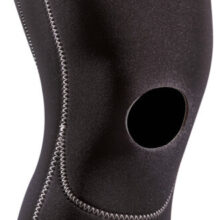Open Patella Knee Sleeve
Login For Dealer Pricing
The Mueller Sports Medicine Knee Sleeve – Open Patella provides soothing warmth and even compression. Open patella design relieves pressure on your kneecap. Fits either knee.
Sore knees are a common complaint that can affect people of all ages and activity levels. Whether it’s due to an injury, overuse, or an underlying condition, addressing the causes and seeking appropriate treatment is crucial for managing knee pain and maintaining mobility.
In this article, we will explore the various causes of sore knees, the diagnostic process, and the available treatment options.
Activities that involve repetitive knee movements or excessive strain, such as running, jumping, or cycling, can lead to sore knees over time. This includes conditions like patellofemoral pain syndrome (runner’s knee) and iliotibial band syndrome.
Ligament sprains or tears, such as an anterior cruciate ligament (ACL) or medial collateral ligament (MCL) injury, can cause acute knee pain and soreness. These injuries often occur during sports activities or sudden twisting motions.
The meniscus is a cartilage structure that provides cushioning and stability to the knee joint. A torn meniscus can cause significant knee pain, swelling, and limited range of motion.
As we age, the protective cartilage in the knee joint can wear down, leading to osteoarthritis. This chronic condition causes inflammation, pain, stiffness, and gradual degeneration of the joint.
Knee bursitis occurs when the fluid-filled sacs (bursae) near the knee joint become inflamed. Excessive kneeling or repetitive pressure on the knee can lead to bursitis, causing pain and swelling.
To diagnose the cause of sore knees, a healthcare professional will typically perform a thorough evaluation, which may include:
The doctor will inquire about the nature of the knee pain, any prior injuries, and relevant medical conditions.
The knee will be visually assessed for swelling, redness, or signs of injury. The doctor may also evaluate the range of motion, stability, and areas of tenderness.
X-rays, magnetic resonance imaging (MRI), or ultrasound may be ordered to examine the internal structures of the knee joint, such as bones, ligaments, tendons, and cartilage.
In some cases, the doctor may remove a small sample of fluid from the knee joint for laboratory analysis. This can help identify infections or inflammatory conditions.
The treatment of sore knees depends on the underlying cause and severity of the condition. Here are some common approaches:
Avoiding activities that exacerbate knee pain and allowing time for rest and recovery is often the initial step. Modifying activities or using knee supports can help protect the joint.
A tailored exercise program focusing on strengthening the muscles around the knee and improving flexibility can help alleviate pain and enhance joint stability.
Nonsteroidal anti-inflammatory drugs (NSAIDs) can be used to reduce pain and inflammation. In some cases, corticosteroid injections may be recommended for short-term relief.
The use of supportive devices, such as knee braces, crutches, or orthotic inserts, can provide stability and offload pressure from the affected area.
In severe cases or when conservative treatments fail, surgical interventions may be considered. These can range from arthroscopic procedures to repair or remove damaged structures, to partial or total knee replacement for advanced arthritis.
Sore knees can significantly impact daily activities and quality of life. Identifying the underlying causes and obtaining an accurate diagnosis is crucial for appropriate treatment.
Whether it requires conservative measures, physical therapy, medications, or surgical intervention, working with a healthcare professional can help manage pain, improve function, and restore mobility in individuals with sore knees.
Early intervention and proper care are key to preventing further complications and promoting long-term knee health.

Login For Dealer Pricing
The Mueller Sports Medicine Knee Sleeve – Open Patella provides soothing warmth and even compression. Open patella design relieves pressure on your kneecap. Fits either knee.